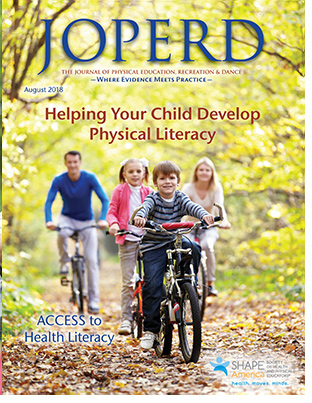 JOPERD Table of Contents
JOPERD Table of Contents
Helping Your Child Develop Physical Literacy
Jeffrey S. Gehris, Amerlia Chloe Simpson, Helena Baert, Leah E. Robinson, Megan MacDonald, Rhonda Clements, Sam Logan, & Sharon Schneider

The development of physical literacy begins in the very early stages of childhood — even before young children enter the school system and are exposed to structured physical education classes. This means that parents are essential allies in building an early foundation for their children’s development of essential skills that will enable them to move with competence and confidence in a wide variety of physical activities, as well as reap important health benefits. Children today are more sedentary than ever, and to a great extent these habits are acquired in the home. How can early childhood and elementary physical educators engage parents to help their children to become physically literate? This article was written with this goal in mind, and it is hoped that it will become a valuable resource to share directly with parents.
Helping Your Child Develop Physical Literacy
As a parent of a young child, you know better than anyone that children love to move their bodies. In fact, it may seem like your child never sits still and is constantly moving all day long. Unfortunately, research tells us that children’s levels of physical activity are at an all-time low, which can lead to health problems such as obesity and diabetes. So what can you do to ensure that your child gets enough physical activity each day? The purpose of this article is to answer that question. The key to helping your child be more physically active is to help him or her develop physical literacy.
What Is Physical Literacy and Why Is It Important for Your Child?
You are probably most familiar with the term “literacy” in relation to children’s reading and writing skills. Physical literacy is defined as the ability to move with competence and confidence in a wide variety of physical activities in multiple environments that benefit the healthy development of the whole person (Mandigo, Francis, Lodewyk, & Lopez, 2012; Whitehead, 2001). You can think of physical literacy as when a child possesses the skills, knowledge and confidence to safely participate in a variety of physical activities that benefit the development of the whole child. The basic skills your child needs to learn to be physically literate are called fundamental movement skills. Fundamental movement skills include such things as hopping and skipping, as well as throwing and catching. These skills must be learned by children. In other words, fundamental movement skills will not just come naturally as your child ages. To be physically literate, your child also needs to understand certain important movement concepts, such as spatial awareness. Spatial awareness is what allows your child to avoid running into someone and getting hurt while playing in the backyard or on the playground. When your child possesses these skills and knowledge, he or she will be confident and excited to engage in physical activity.
To read the rest of this article,
click here to download a pdf.